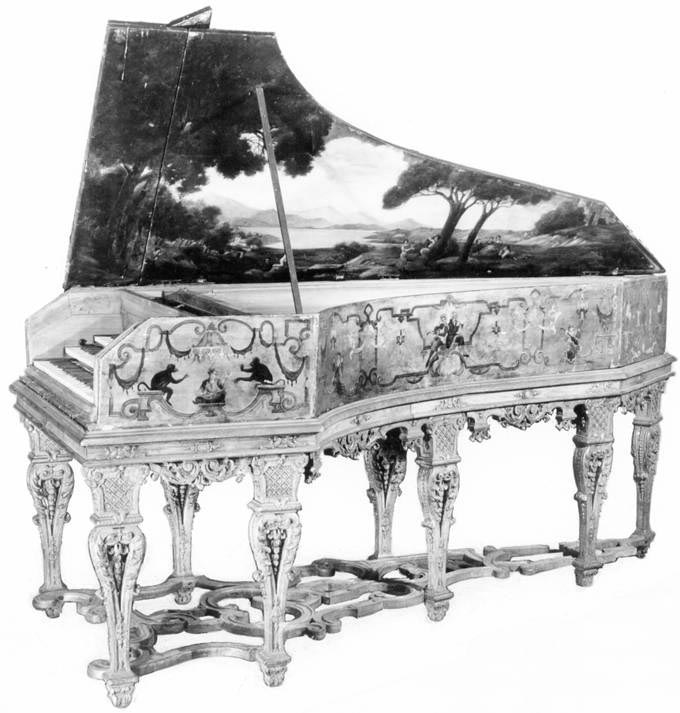![]()
Grant O’Brien
Full details of the analysis of the original state of this instrument can be found in an article written by me: ‘Towards establishing the original state of the three-manual harpsichord by Stefano Bolcioni, Florence, 1627, in the Russell Collection of Early Keyboard Instruments, Edinburgh’, The Galpin Society Journal, 53 (2000) 168-200. ISSN 0072.0127.
The triple-manual harpsichord signed by Stefano Bolcioni, Florence, 1627
The harpsichord in the Russell Collection of Early Keyboard Instruments at the University of Edinburgh signed ‘STEFANVS · BOLCIONIVS · PRATENSIS · F · A·D · M·D·C·XXVII F’[15] is a good example of an instrument which has had a chequered history and which, in its present state, does not in any way represent its original nor any intermediate historical state. It presently has a disposition of 2 x 8', 1 x 4' with three uncoupled keyboards and three registers, one per keyboard. It has an elaborately-decorated outer case in a kind of Italian vernis-martin mannerist style, and a complex stand in the style of Louis XIV (see Figure 8). A photograph of this instrument appears in the catalogues of Leopoldo Franciolini[16] with three keyboards and the same outer case but with a totally different decoration and stand[17]. It is clear that the present state is totally inauthentic and dates from a ‘re-working’ of the instrument around the time when it was offered for sale by Franciolini at the end of the nineteenth century. Because of the extent of the drastic alterations to the instrument it has hitherto been impossible to establish the original compass, disposition, scalings and pitch of this instrument with any certainty[18].
In the short time I have available here I can only present the highlights of the analysis of this instrument, but I will publish the full analysis in the next issue of The Galpin Society Journal[19]. The analysis below is an attempt to show how the original dimensions of the baseboard used by Bolcioni to design and construct this instrument can be determined using the Florentine soldo[20], and comparison with the only other surviving Bolcioni harpsichord in the University of Yale. Once the baseboard dimensions have been determined, this can be used to estimate the original scalings, and further analysis also allows the determination of the original compass. All of these analyses rely on the initial determination of the unit of measurement used in its design and construction, and the subsequent use of this unit to help to determine the scalings and compass. This is a procedure not previously applied to this radically-altered instrument.

Figure 8 - ¾-view photograph showing the present state
Three-manual harpsichord by Stefano Bolcioni, Florence, 1627
Russell Collection of Early Keyboard Instruments, Inv. No. HT1-SB1627.4
The 1627 Bolcioni harpsichord has unusual sloping cheekpieces beside the keyboard instead of the usual keywell scrolls. Close examination shows that these are not original but have been added on with lap joints to the main spine and cheek sides. Comparison with the Yale Bolcioni shows that, in order to have used similar cheekpieces, there must now be about 20½mm missing from the front of the baseboard of the Edinburgh harpsichord. Adding this missing 20½mm results in the measurements given in Table 2 which are shown in the left-hand part of the diagram of Figure 9.
The
value of the Florentine soldo used in
the Edinburgh Bolcioni can be calculated in the usual way. The tangent of the tail angle is tan 38½º =
0.795 ≈
0.80 = ![]() . The ratio
. The ratio ![]() suggests that the two
orthogonal components of the triangle that form the tail angle are 8 soldi and 10 soldi which, mathematically, would form an angle of 38.66º, which
is very close to the measured angle of 38½º.
A summary of the original measurements of the baseboard, baseboard
construction lines and the case height in soldi
is given in Table
2, where the lengths of the soldo
calculated from each of these are shown at the right:
suggests that the two
orthogonal components of the triangle that form the tail angle are 8 soldi and 10 soldi which, mathematically, would form an angle of 38.66º, which
is very close to the measured angle of 38½º.
A summary of the original measurements of the baseboard, baseboard
construction lines and the case height in soldi
is given in Table
2, where the lengths of the soldo
calculated from each of these are shown at the right:
Measurement Local Length of
in mm unit soldo
Tail angle component parallel to spine: 273½ = 10 soldi gives 27.35
Tail angle component perpendicular to spine: 220 = 8 soldi gives 27.50
Spine (long bass side)*: 1981½ = 72½ soldi gives 27.33
Baseboard
width: 756½ = 27![]() soldi
gives
27.34
soldi
gives
27.34
Cheek (short
treble side)*: 537½ = 19![]() soldi gives
27.33
soldi gives
27.33
Case sides height: 219 = 8 soldi gives 27.38
Case front to nut line (bass side)*: 164½ = 6 soldi gives 27.42
Case front to nut line (treble side)*: 273½ = 10 soldi gives 27.35
Case front to belly rail
(bass side)*: 391½ = 14![]() soldi
gives
27.31
soldi
gives
27.31
Case front to belly rail
(treble side)*: 373½ = 13![]() soldi gives 27.33
soldi gives 27.33
Totals: 5191 = 189![]() soldi Average: 27.345mm
soldi Average: 27.345mm
*These measurements have each
been corrected by adding 20½mm.
Table 2
Three-manual harpsichord by Stefano Bolcioni, Florence, 1627
Russell Collection of Early Keyboard Instruments, Inv. No. HT1-SB1627.4
This calculation gives a value of the soldo that compares with a value of 27.29mm found for the 1631 Bolcioni harpsichord in Yale University, a value of 27.401mm found for the Francesco Poggio virginal discussed above, a value of 27.341mm given by both Diderot (1751) and Krünitz (1788)[21], a value of 27.408mm given by Larousse[22] and the value of 27.53mm given by Colonel Cotty (1819)[23]. The similarity to one another of the values of the soldo found for the two Bolcioni harpsichords, and the similarity of these to the values given in the historical sources of metrology, confirms that they were all made in Florence using the Florentine braccio and soldo, and this fact helps to confirm that the instrument was indeed made by Bolcioni[24].

Figure 9
in units of the Florentine soldo used by Bolcioni = 27.345mm (right)
Three-manual harpsichord by Stefano Bolcioni, Florence, 1627
Russell Collection of Early Keyboard Instruments, Inv. No. HT1-SB1627.4
The shaded portion at the front of the baseboard seen in Figure 9 shows the amount which seems to have been removed in order to accommodate an intermediate state C/E to c3 keyboard with pedal pull-downs and short keylevers. The various lines shown are scribed on the baseboard and indicate the original position of the nut, and the original position of the sides of the lower belly rail. Clearly, if my assumption about the scroll of this harpsichord having originally been the same as that on the University of Yale Bolcioni so that 20½mm were removed from the baseboard of this instrument, the nut and the belly rail were positioned using simple integers and fractions of Florentine soldi as would be expected.
Figure 10 shows a schematic representation of the cheek section, and of the probable original form of the keywell for the Edinburgh Bolcioni. Here the keywell scroll of the Yale University Bolcioni harpsichord of 1631 has been added on at the point where the present join in the cheek begins (dashed line) and the batten in front of the baseboard of the Yale University Bolcioni has been drawn in (shaded). An added section 20½mm wide (shaded) has had to be added to the length of the baseboard in order to accommodate the Yale cheek piece as discussed above.





